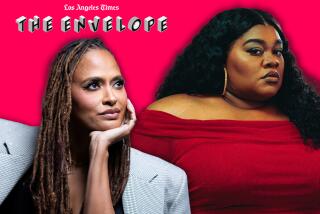French filmmaker Katell Quillévéré bridges medicine and metaphysics with ‘Heal the Living’
- Share via
Perhaps the most memorable image in “Heal the Living,” the intensely moving medical drama from French writer-director Katell Quillévéré, is of a heart beating in a teenage boy’s chest. The organ pulses gently several times, mere moments before it is delicately lifted by a surgeon, stored in a container and sent to the gravely ill woman who awaits it.
For Quillévéré, the emotion of the moment — a tenuous link between two lives, one at an end while the other awaits a reprieve — would depend on a foundation of verisimilitude. She worked closely with medical professionals while researching and shooting the film, and sat in on a number of heart transplants.
“I felt I needed to be as close as possible,” she says. “We observe the heart as just this muscle that is taken from one body and then re-sewn into another. Even though it’s very realistic, there is still something very magical and mysterious that you experience when the heart starts to beat again.”
Even though it’s very realistic, there is still something very magical and mysterious that you experience when the heart starts to beat again.
— Katell Quillévéré
That transmutation of the scientific into the sublime is essential to the power of “Heal the Living,” which is, among other things, a meticulously detailed portrait of doctors at work. While some of the doctors’ roles are filled by well-known talents — Belgian actor and filmmaker Bouli Lanners plays a top surgeon, while French actor Tahar Rahim plays an organ donation consultant — the restraint of their performances and the tenderness of Quillévéré’s gaze lend their on-screen ministrations an almost spiritual intensity. Their life-saving craft is not merely observed but exalted.
So too are the patients and their loved ones who, at the most painful and uncertain moments of their lives, come under the doctors’ care. The film’s simple, wrenching story, adapted by Quillévéré and Gilles Taurand from a novel by Maylis de Kerangal, is set in motion when Simon (Gabin Verdet), a vivacious and athletic teenager, is seriously injured in a car accident.
Simon is declared brain-dead, but his other organs are found to be in near-perfect condition, making him a potential lifesaver for Claire (Anne Dorval), a middle-aged woman in need of a heart transplant. Understandably nervous about such an operation, Claire struggles to share her feelings about her uncertain future with her two young sons (Finnegan Oldfield and Theo Cholbi), even as Simon’s grieving parents (Emmanuelle Seigner and Kool Shen) prepare to bid farewell to their child far too soon.
First screened at the 2016 Venice and Toronto film festivals before it was acquired for release by Cohen Media Group, “Heal the Living” is the third feature written and directed by 37-year-old Quillévéré. It opened in Los Angeles on Friday.
Born in Abidjan, Ivory Coast, and raised in Paris, where she studied film and philosophy, she made her feature directing debut in 2010 with “Love Like Poison,” about a 14-year-old Catholic girl struggling to reconcile her faith with her nascent sexuality. It premiered at Cannes and later won the prestigious Prix Jean Vigo, given annually to a French film notable for its independent spirit.
The director returned to Cannes in 2013 with “Suzanne,” a boldly elliptical drama that spans about 25 years in the life of its eponymous heroine.
Speaking by phone from Paris, Quillévéré describes “Heal the Living” as a film of many personal precedents. In addition to being her first picture to receive theatrical distribution in the U.S, it’s also her first adaptation of existing source material and her first truly ensemble-driven film.
“I feel a certain reticence toward ensemble filmmaking,” she says, noting the difficulty of achieving depth of character within limited screen time, particularly when working with seasoned actors who bring their own familiar screen associations to each role. Fortunately, she adds, her cast intuitively grasped the demands of the material. “They all understood very fast, from the moment they read the script, that it was about them being part of a whole, a collective.”
The idea of the actors working in concert, passing the baton from one narrative thread to the next, provided the film with a graceful structuring principle and a powerful metaphor. The smooth, fluid movement of the camera, Quillévéré decided, would become the movie’s thematic lifeblood — a visual embodiment of blood coursing through human veins.
“We decided that movement was going to be the identity of the film, the DNA of the film,” Quillévéré says.
The cinematographer, Tom Harari, moves the camera with extraordinary grace in “Heal the Living.” In a bittersweet flashback, the camera hovers alongside Simon as he speeds uphill on his bicycle, racing to catch up with a girl who’s caught his eye. The film’s blissfully kinetic opening scenes follow Simon as he skateboards through the streets of his hometown, Le Havre, and then goes surfing with his friends, just a few hours before his fatal accident.
All this meaningful movement is echoed by the gently rippling progressions of the score composed by the prolific Alexandre Desplat, who dispensed with elaborate string orchestrations in favor of a simple, resonant piano theme.
“He’s a genius,” Quillévéré says. “I guided him only in asking him to find something that could embody melancholy but also optimism. There is sadness, but life always goes on.”
More to Read
Only good movies
Get the Indie Focus newsletter, Mark Olsen's weekly guide to the world of cinema.
You may occasionally receive promotional content from the Los Angeles Times.









